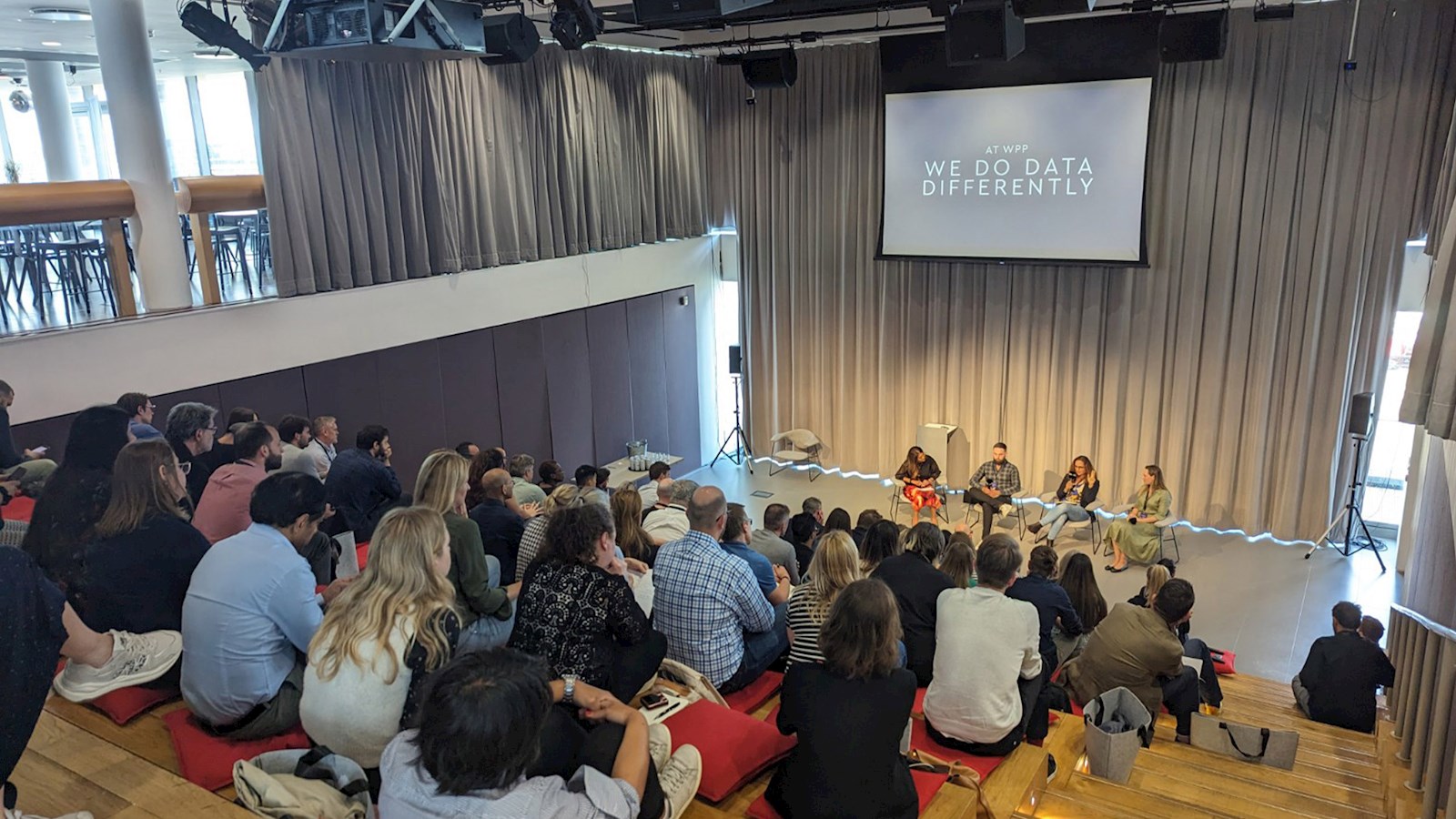
Doing data differently at WPP
The end of third-party cookies, changing data privacy laws and increased regulation are what we are working with now. And that is exciting, says WPP’s Global Head of Data and AI, Di Mayze
The future for data will be different. Adaptation and agility are needed; and so too are alternatives to our continued obsession with individually identifiable information.
While AI and the metaverse have – understandably – stolen the headlines in recent years, it’s now time to talk loudly and optimistically about data and the new third-party cookie-less environment in which all organisations will operate. Innovative and responsible approaches to data collection and use are where we are at.
The future is not simply about more technology and more data. It is about supporting CMOs to use the data they do have (with purpose, ethically and clear intent), optimise it appropriately and remember that, while CMOs might not have all the data they need; they also don’t use all the data that they have.
Six traits of a data-powered organisation
Data fuels business, but we have learned from decades of experience that a data-volume goal without thought or purpose is the enemy of a data-powered organisation. We also know that variety of data is a good thing. And we should think not only about the data that is available as individual datasets but what data – we already have access to – can be blended.
We also need to think about velocity. How fast does your data need to move? And the veracity of our data is vital.
We should think about the value of our data, and it should be optimised for the long term. Finally, the variability of data needs to be considered. Organisations must be able to respond to the changing nature of data.
Unless these six traits are embraced by an organisation, its data will not sing. And, importantly, it will not perform well as the foundations of its AI strategy.
AI depends upon the right data
As WPP’s Chief AI Officer, Daniel Hulme, says: “You don’t need all of the data in the world, you need the right data that contains the right signals.” He defines AI as “goal-directed adaptive behaviour” but concedes that AI systems used by companies today are less interested in the ‘adaptive’ element as we tend to ask machines to do the same thing over again.
He insists we should look at AI through the lens of application – not that of technology – which will free organisations to innovate in a safe way. We have communicated widely on our assertion that there are six applications of AI. These will help define a framework for understanding the evolution of AI as a force for good and, importantly, its potential for doing harm, and therefore requiring intervention.
But there will always be challenges. We must understand the provenance and authenticity of data, and we have to think long and hard about the data we use inside large language models. That is why WPP is already working with partners to create clean rooms and walled gardens.
AI use cases across WPP continue to build. One goal is to build digital twins of organisations to help them to adapt to new environments, enable them to run simulations and adjust to a rapidly changing world.
While AI will free people from mundane tasks and unlock their creativity, explain-ability is critical. That is why mechanisms are already in place to understand how AIs make decisions, thereby solving the transparency problem.
Daniel maintains that “knowing stuff – in the future – will not be important”. Having an engineering mindset will be useful. Being able to understand failure points and orchestrate people – these are things that will be valuable going forward.
Better data; better outcomes
As Manjiry Tamhane, Global CEO of WPP’s Gain Theory, says, organisation that ground their decisions in data do better. But we know there is a long way to go. Some estimates suggest that only one in five business decisions made is based on data. That is shocking.
So, what is holding businesses back? A dearth of data strategy developed by growth teams themselves, a disconnect between the growth team’s strategy and that of the organisation, a lack of buy-in generally, fragmentation of audiences, and the challenges associated with measurement (measuring the wrong things or measuring the right things but not in a way that is connected with the rest of the business).
What is clear is that for a data strategy to succeed, it must align with the corporate strategy. It must be embedded in lots of areas of the business, and authority and capability must sit with individuals – they must be empowered to act.
And growth teams will only ever trust the insights surfaced by data if they are empowered to request the insights they need – and this will vary by market, by brand and by many other metrics. As the phasing out of cookies continues, and regulation comes into force, there will be a scramble for alternative measures, including the use of AI.
Marketers will have to think carefully about how they implement AI-based measures if they are to ensure transparency. This is why a broad toolkit is what is needed now. Don’t just leverage the data that is a by-product of your operations; have the vision to do data by design. And don’t forget about the power of creativity to connect with brands – over and above the use of data.
Where are we headed? Towards occasions
At WPP, we are invested in better understanding the moments and experiences that enrich our lives. As Carol Reed, WPP’s Chief Innovation Officer of Marketing and Growth, points out, occasion-led marketing is a powerful response to the questions we are facing. How do we solve for personalisation at scale? And how do we do that in a way that is easy and effective?
Most identity driven data defines past behaviour and preferences, and the typical activation of audience segments occurs without regard to when and where a person is. This can result in advertising that seems out of place, irrelevant and creepy. Additionally, consumer personas and journeys are getting harder to define, partly because society is changing too. Our younger generations are more diverse in terms of background, interests and how they identify themselves – from gender to social communities. There is an on-going fragmentation of our traditional user personas. Weird is cool now, and normal is becoming the exception.
Marketers need to focus more on real-world context – where people are, what they are doing, what moments they are universally experiencing and sharing together. The Occasions Graph, the newest data product from Choreograph, helps marketers predict and recognise hundreds of everyday occasions in real-time – from weekend BBQs, mealtimes away from home, mid-week commutes, to attending concerts and sporting events live. This gives marketers the power to reach customers in the present moment with context and, most importantly, deliver relevant messaging in a way that does not feel intrusive.
Leveraging the same technology advancements that have enabled the recent boom in AI, the Occasions Graph is backed by a completely modern and new organising data principle never used before in marketing: a multi-dimensional spatiotemporal data grid. As a result of organising, sharing and processing data differently, the Occasions Graph transcends many critical data challenges experienced by legacy cookie and identity-based solutions, including privacy regulations, third-party cookie deprecation and browser limitations.
WPP is revolutionising personalisation. Scalable relevance is the future, powered by a data approach that is faster, cleaner, privacy safe and available worldwide.
Small steps; big outcomes
My colleague Evan Hanlon of WPP’s Choreograph exhorts marketers to experiment to drive results. He says make improvements in data strategy incrementally: “When you start thinking about activation, there is an opportunity to improve the systems approach of tomorrow. Create a flywheel. That will help you find out what your true north looks like.”
Evan urges us to resist focusing on past behaviour but to focus on the now. Look at what people are searching for, use signals, he says. He predicts that the future will increasingly be about federated learning as the dominant post third-party cookie design pattern.
Ultimately, as WPP’s CTO, Stephan Pretorius, points out, doing data differently is what is needed now, and this way of thinking is fuelling WPP’s data strategy. Whether it is federated learning, occasions thinking or new ways to use data to drive growth, the appetite for a new approach – and the desire to talk about it – is palpable.
published on
17 July 2023
Category
More in Technology & data

How to build your brand in-game
A new research report from WPP and SuperAwesome

WPP puts itself at the heart of collaborative 3D worlds
Pixar's 3D animation file format – USD – is the invisible building block of our digital 3D future.

A clarion call for AI, accessibility & advertising
Innovating at the intersection of AI, accessibility, and advertising

